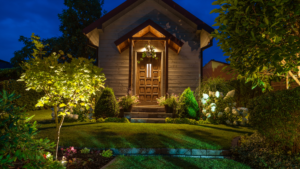 Garden lighting is practical, comforting, and captivating. It allows you to safely navigate your backyard environment, while providing intensity, direction, movement, color, and contrast to an otherwise dark space. However, if garden lights aren’t well managed, they can wind up costing more than you bargained for. Here are a few efficient ways to light your garden that will help save money while creating a tranquil and relaxing ambiance at the same time.
Garden lighting is practical, comforting, and captivating. It allows you to safely navigate your backyard environment, while providing intensity, direction, movement, color, and contrast to an otherwise dark space. However, if garden lights aren’t well managed, they can wind up costing more than you bargained for. Here are a few efficient ways to light your garden that will help save money while creating a tranquil and relaxing ambiance at the same time.
Invest in LED Lights
In the old days, before the invention of LEDs (Light-Emitting Diodes), when homeowners had to rely on incandescent bulbs, outdoor lighting was expensive. Incandescents consume roughly 60 kilowatt hours of electricity over their lifespan and only last 1,200 hours, while an LED uses only 10 kilowatts and lasts twenty-five times longer.
LEDs shine as brightly as incandescents, so switching over won’t impact your lighting design. In fact, it could improve it. LEDs come in as many varieties as incandescents (pathway lights, outdoor lanterns, spike lights, spotlights, overhead lights, etc.) and a few extra ones as well, such as lighting strips, which can be strung discreetly beneath planter boxes or umbrellas.
Install Solar Lights
Solar lights are equipped with photovoltaic cells: panels that convert sunlight into electricity. The cells charge batteries over the course of a day. Once the sun sets, the lights switch on and burn until the battery’s exhausted. A solar battery lasts up to twenty-five years, so you won’t pay much beyond the initial purchase cost.
And because solar lights aren’t connected to your electrical system, they’re far easier to install ‒ no professional help required. A typical solar light, charged for seven hours in the sun, is generally strong enough to run for eight to nine hours through the night.
Watch Your Voltage
Outdoor lights don’t need to be powerful to be effective. In fact, bright lights are often counterproductive. They annoy your neighbors and overwhelm your guests. They also consume a lot of electricity. To control costs and ensure a pleasant atmosphere, stick to bulbs 15 watts or less.
Set Up Motion Sensors
Leaving your porch light on all night lets people know you’re home and deters potential burglars. Others are better used only when needed ‒ path lights, for example. Connecting them and similar lights to motion sensors ensures power is spent only when you’re out in your garden, not continuously until sunrise.
Put Your Lights on a Timer
Timers are another efficient way to control energy consumption. Set them to turn on at sunset and off again at midnight, sunrise, or whenever you feel is best. Once you set the schedule, the device takes care of the rest.
Install Daylight Sensors
While timers have to be updated periodically as seasons change, daylight sensors keep your garden lit without any effort at all. They adjust light levels automatically, gradually raising them as the sun sets and lowering them again when it rises.
Save Money with Agway
Agway wants to help you save money. It’s why we’re always looking for new ways to make your home more energy efficient and why we launched our EnergyGuardTM Program. It covers your house’s heating, cooling, and electrical systems*. Restoring critical components can cost hundreds of dollars, potentially upending your household budget in the process. EnergyGuardTM helps shoulder some of the burden and reduce out-of-pocket expenses.
When the need for repair occurs, our support team schedules the repairman and pays for all corrective maintenance and covered parts. There are no service fees or deductibles. Everything is included in your supply cost, including peace of mind. Save on repairs. Sign up today!
*Coverage depends on commodity purchased.